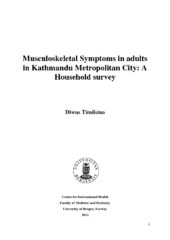| dc.description.abstract | Objective: - To obtain information about musculoskeletal symptoms (MSS) in Kathmandu Metropolitan City (KMC), Nepal. Method: - A descriptive cross-sectional study was performed in KMC. There are 35 different wards (areas) in the KMC and wards were chosen using ‘probability proportional to size’ cluster technique. It was decided to have 30 clusters, 24 wards were selected out of 35 wards (as some wards had more than one cluster) and 22 individuals were interviewed from each cluster. In each selected ward, one roundabout at the center of the ward was chosen at random. At each roundabout, the direction was chosen at random and then the first 22 households in that direction were interviewed. A structured interview was performed based on standardized instruments; a standardized Nordic questionnaire (SNQ) was used to obtain information about MSS and to obtain information on functional ability (COOP-WONCA) charts were used. Also demographic data was collected. Result: - Six hundred and sixty six persons were interviewed. According to the body part the four most commonly reported regions with musculoskeletal symptom were low back (37.7%), knee (27.0%), ankle (14.8%) and wrist and hand (9.1%) during the previous 12 months. Similarly according to the body parts the four most commonly reported regions with musculoskeletal symptoms in the last 7 days were low back (26.8%), knee (19.4%) and ankle (10.0%). After adjusting for age, BMI and smoking the prevalence of musculoskeletal symptoms were higher in females than in male in all different body parts. Prevalence of musculoskeletal symptoms was higher in those aged above 36 years and in those who had low functional ability. Prevalence of shoulder, elbow, wrist/hand, upper back, lower back, hip, knee and ankle/foot symptoms were significantly higher in persons with low physical fitness than the persons with normal physical fitness. Among person with low physical fitness 4 prevalence of back symptoms and knee symptoms were 38 and 51 percentage respectively. Prevalence of shoulder, elbow, wrist/hand, upper back, lower back, hip, knee and ankle/foot symptoms were significantly higher in persons with low daily activity and low social activity than the persons with normal daily activity and normal social activities. Prevalence of shoulder, elbow, wrist/hand, upper back, lower back, hip and knee symptoms were significantly higher in persons with low score on feelings than the persons with normal feelings. In this study, 272 (59.1%) of the individuals did not seek any medical healthcare when they had musculoskeletal symptoms whereas 154 (33.5%) went to doctor, 17 (3.7%) went to doctor and physiotherapist, 5 (1.1%) went to physiotherapist, 5 (1.1%) went for Ayurvedic (treatment with medicinal plant) treatment, 3 (0.7%) went to traditional healer and 3 (0.7%) went to doctor and traditional healer when they had musculoskeletal symptoms. Conclusion: - This study adds to the knowledge about musculoskeletal symptoms in the general population in KMC. Prevalence of symptoms from low back and knees are most common in general population of KMC. Musculoskeletal symptoms are more common among females than males and more common among those aged above 36 years and among those reporting low functional ability. The healthcare involved in the treatment of persons with MSS should be explored further in the Nepal population, to find the causes of these problems and proper methods for prevention. | en_US |
